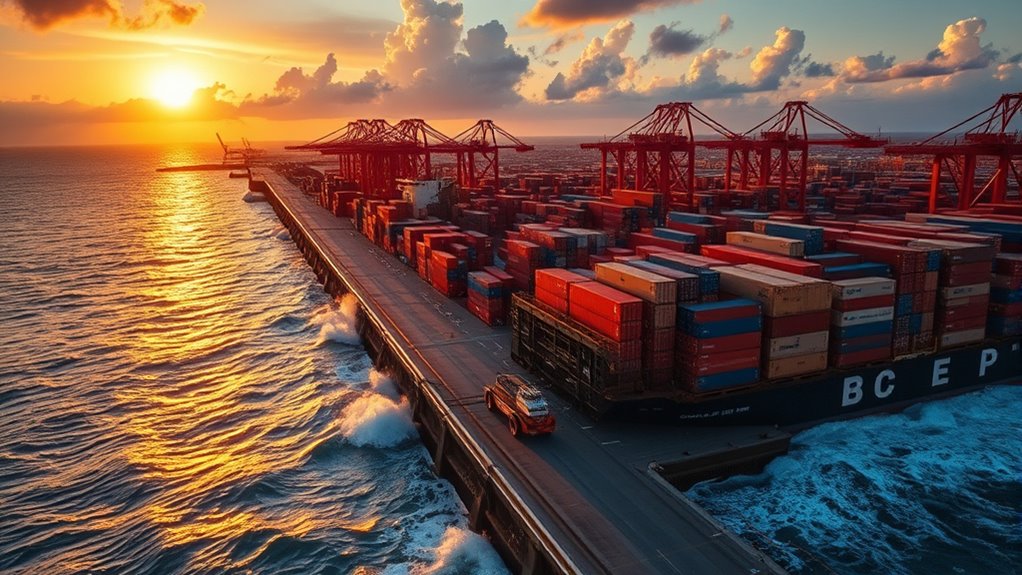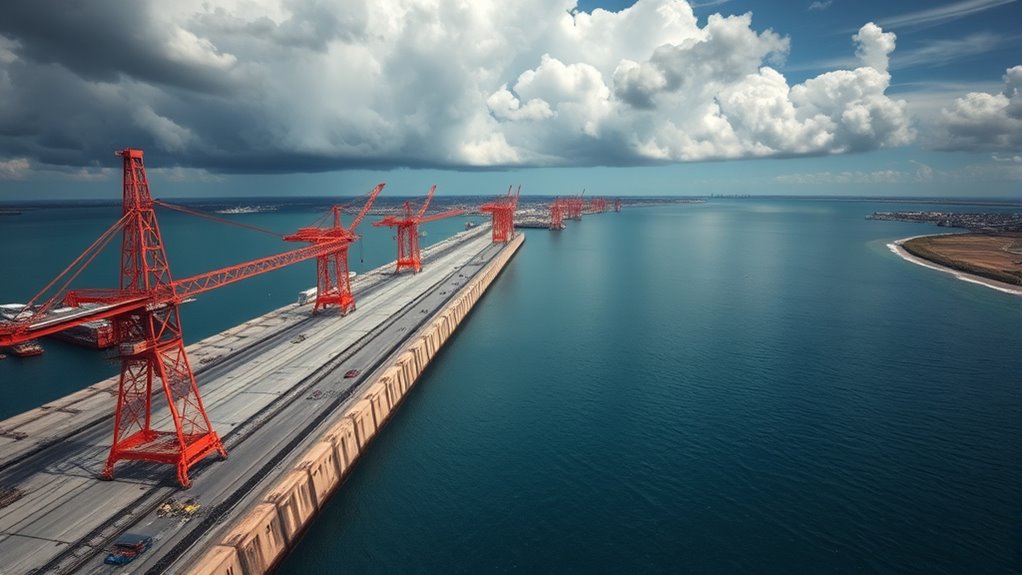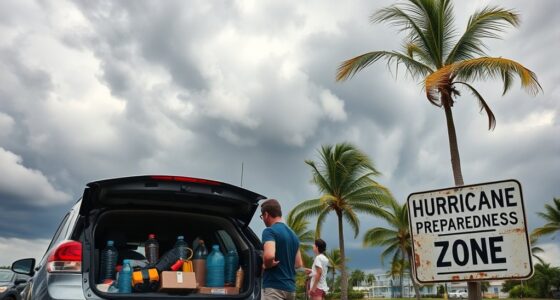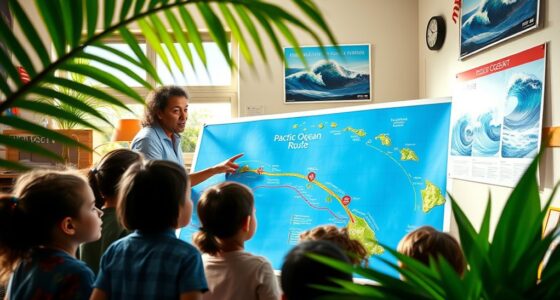Gulf Coast ports are ramping up upgrades to strengthen hurricane defenses, prioritizing the safety of essential infrastructure and communities. Major projects, like the Port Arthur initiative, focus on flood mitigation and protective structures. These enhancements are designed to withstand storm surges of up to 14 feet, ensuring economic resilience and stability. As a result, 102,000 residents and critical facilities gain protection. Want to discover more about these transformative efforts and their impact?
Key Takeaways
- Gulf Coast communities are upgrading port defenses to better prepare for the hurricane season and protect vital infrastructure.
- The U.S. Army Corps of Engineers is overseeing major upgrades, including flood mitigation and protective structures at key facilities.
- The Port Arthur Project aims to safeguard 10% of U.S. petroleum supply and protect 102,000 residents from flooding.
- Upgrades include systems designed to withstand storm surges of up to 14 feet, enhancing local pumping stations’ capabilities.
- A $28.87 billion investment in Texas Gulf Coast plans includes constructing storm barriers and surge gates for comprehensive coastal protection.

As Gulf Coast communities brace for hurricane season, major upgrades to port defenses are underway to guarantee safety and resilience. You’ll find that the U.S. Army Corps of Engineers (USACE) is playing an essential role in this effort, collaborating with local partners to secure funding—65% of which comes from the federal government. These enhancements are critical, especially for the Port Arthur Project, which protects important refineries that provide about 10% of the U.S. petroleum and safeguard the lives of 102,000 residents.
The upgrades focus on flood mitigation and the construction of protective structures for indispensable pumping stations. The PAV03A segment of this project alone involves a contract worth $102.5 million, set to be completed in about four years. You can see the partnership between USACE, the Jefferson County Drainage District No. 7, and the State of Texas as a strong pillar for these improvements, guaranteeing that both local and national interests are prioritized.
Hurricane protection is a top priority, with the new systems designed to withstand storm surges up to 14 feet above mean sea level. Key features of the PAV03A segment include enhancements to the Lakeside, Alligator Bayou, and Port Acres pumping stations. This collaborative management means USACE oversees design and construction while the Drainage District handles operation and maintenance, allowing for a streamlined approach to community safety.
Beyond Port Arthur, the Texas Gulf Coast Plan aims to protect residents and infrastructure with a $28.87 billion investment. Proposals such as the Ike Dike and Galveston Ring Barrier focus on constructing storm barriers and surge gates to further enhance safety. These initiatives represent a multi-layered coastal protection strategy that could greatly reduce risks during hurricane season.
As ports along the Gulf Coast monitor potential storms, preparation measures remain essential. You’ll notice that operations continue while guaranteeing readiness for severe weather. Weather forecasts suggest considerable rainfall in the area, which underscores the importance of these upgrades. The Port Authority’s proactive stance indicates an awareness of impending storms, allowing them to respond effectively.
Ultimately, these upgrades not only protect infrastructure but also maintain economic resilience. By safeguarding critical facilities, you help guarantee that the local economy remains stable during storms. This means job security for community members and the continuous operation of important industries, making these upgrades not just a necessity but a lifeline for Gulf Coast communities.
Frequently Asked Questions
How Often Do Hurricanes Impact Gulf Coast Ports?
Hurricanes impact Gulf Coast ports frequently, with all but one of the 18 major hurricanes since 1999 hitting the region.
You’ll notice that smaller storms have doubled in occurrence, which means these coastal areas face more regular disruptions.
The trend shows that storm intensity is increasing, leading to more severe economic impacts on shipping and logistics.
It’s essential for ports to adapt and prepare for these growing threats to guarantee operational resilience.
What Specific Upgrades Are Being Implemented at These Ports?
Did you know that ports along the Gulf Coast handle approximately 30% of the nation’s cargo?
To enhance their resilience, these ports are implementing significant upgrades. You’ll find strengthened docking facilities, improved drainage systems, and advanced monitoring technologies to guarantee quick responses during storms.
Collaborating with local, state, and federal agencies, they’re focused on preemptive measures to minimize potential impacts, assuring safety and efficiency for both operations and community resources.
Who Funds the Hurricane Defense Upgrades?
When it comes to funding hurricane defense upgrades, several sources play a vital role.
You’ll find federal funding from agencies like the U.S. Army Corps of Engineers and FEMA, along with support from state agencies like the Texas General Land Office.
Private sector contributions often come into play, too, through public-private partnerships that help finance large-scale projects.
Together, these funding sources guarantee effective storm defenses are built and maintained.
How Do These Upgrades Affect Shipping Costs?
Isn’t it ironic how upgrading ports to withstand hurricanes can actually raise shipping costs?
You might think better protection would lower expenses, but the significant investments required can lead to higher fees. As ports reinforce structures and implement new technologies, carriers often pass those costs onto you.
Plus, disruptions from storms still prompt rerouting and delays, adding to the financial burden.
Will These Defenses Be Effective Against All Hurricane Categories?
No, these defenses won’t be effective against all hurricane categories.
While they may handle Category 1-3 hurricanes well, stronger storms present a challenge.
You’ll see uncertainty in how these systems perform during higher category hurricanes due to their unpredictable intensity and tracks.
It’s vital to enhance resilience and adapt to changing conditions to guarantee your safety and infrastructure protection during severe weather events.
Continuous monitoring and improvements are essential for effectiveness.
Conclusion
As the Gulf Coast ports strengthen their hurricane defenses, they’re not just reinforcing walls; they’re building a fortress against nature’s fury. You can feel the determination in the air, like a ship braving the tempest with a sturdy hull. With every upgrade, they’re not only safeguarding cargo but also the lifeblood of the communities they serve. In this battle against the storm, hope rises like the tide, promising resilience and a brighter future for all who depend on these essential waterways.










